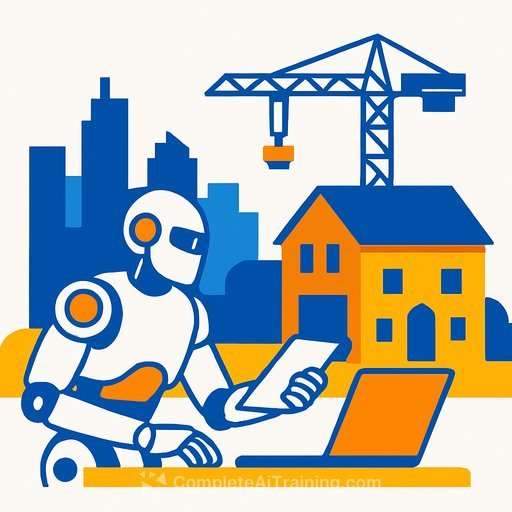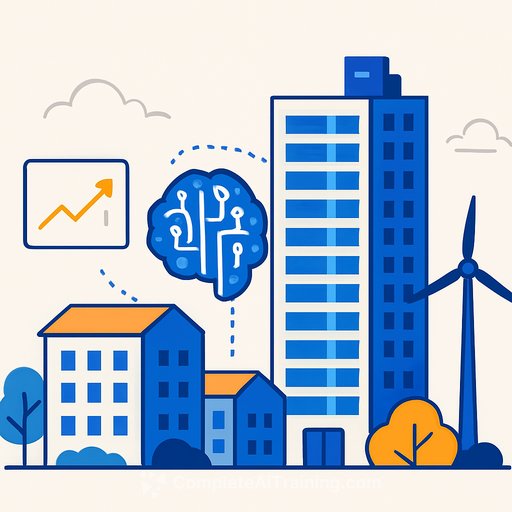Built World AI: A practical roadmap for 2025 and beyond
The built world touches nearly a quarter of U.S. GDP, yet it's still one of the least digitized sectors. Multimodal AI is the unlock: faster decisions, cleaner handoffs, and fewer costly mistakes across design, build, and operations.
Think in workflows, not buzzwords. If a tool shortens cycles, reduces risk, or improves margin, it matters. Everything else is noise.
Key insights
- The moment: Construction and real estate are language-heavy and multi-stakeholder. That's exactly where LLMs and vision models shine.
- Construction AI: Design generation, takeoff and estimation, on-site coordination, knowledge management, and robotics will drive the biggest gains.
- Real Estate AI: Broker and agent automation, property search and discovery, property management orchestration, and design/visualization are ripe now.
- Why now: Productivity is flat in construction, tech spend is low, and workflows are fragmented. Multimodal AI fixes coordination at scale.
I. Construction AI
Why now: the productivity gap and coordination problem
U.S. labor productivity rose more than 290% over six decades. Construction moved the other way-shrinking almost a percentage point per year from 1970 to 2020. That's painful for a sector with seven million workers and $1.3T in annual value.
Labor shortages, interest rate pressure, input volatility, and supply chain risk make execution harder. Firms spend about 2.7% of revenue on tech-the lowest of any major industry, leaving clear room to improve. Source. For background on the long-running productivity lag, see research.
The work is language and geometry at once: contracts, drawings, RFIs, change orders, schedules, inspections, and field reports-across 15+ stakeholder groups. Multimodal LLMs can finally thread this needle.
Five areas of opportunity
- Design generation: Move from computer-aided to computer-generated design. Produce code-compliant, cost-aware 2D/3D options on demand. Teams like Higharc, Finch, and Augmenta are pushing here. The moat will live in parametric geometry and reasoning depth.
- Takeoff & estimation: Auto-generate assemblies, quantities, and updates as plans change so estimators can focus on strategy and margin. Bild AI, Drawer AI, and SketchDeck AI show where this is heading.
- On-site coordination: Capture voice, image, video, and text in the field to auto-create RFIs, safety logs, and progress notes-timestamped, translated, and linked to sheets and locations.
- Knowledge management: One query-driven source of truth across contracts, drawings, RFIs, and change orders. Trunk Tools and TwinKnowledge point to this future.
- Construction robotics: Semi-autonomous and autonomous equipment, controllable through simple interfaces and eventually natural language. Terrafirma and Bedrock Robotics are early signals.
Five principles for Construction AI founders
- Value creation: Deliver direct margin impact-clear savings or revenue, not "nice to have" efficiency.
- Pain points: Solve cross-stakeholder bottlenecks that delay schedules or change costs-not isolated tasks.
- Data advantage: Build compounding datasets (cost libraries, annotated plans, project histories) that improve accuracy over time.
- Integration depth: Meet teams in their current tools and workflows. Reduce behavior change to speed adoption.
- User empathy: Build for the estimator, superintendent, project engineer, and field crews. Context decides usage.
II. Real Estate AI
Why now: automate the busywork, protect the relationships
Real estate depends on local knowledge and trust. But teams grind through manual work: spreadsheets, PDFs, legacy property systems, and scattered comms. Meanwhile, affordability is strained and operating costs are up.
LLMs and vision models can reason across unstructured data and plug into incumbents. The result: faster cycles in sales, leasing, payments, ops, and maintenance-without replacing the human connection that closes deals.
Four areas of opportunity
- Broker & agent automation: Free agents from email, lead nurture, scheduling, paperwork, valuations, and compliance. Serif, Fyxer, Closera, HenryAI, and AI-enabled brokerages like TurboHome demonstrate the path to leaner commissions and better client time.
- Property search & discovery: Move past static filters to conversational, context-aware search that covers neighborhoods, condition, and investment potential. For consumers, search becomes a co-pilot-from query to close. Even large portals are testing this direction.
- Property management: Layer LLM workflows on top of entrenched systems to orchestrate leasing, renewals, maintenance, and resident ops. EliseAI and SurfaceAI showcase this "extend, don't rip-and-replace" approach.
- Design & visualization: Generate high-quality, personalized visuals for staging, layout, and marketing in minutes. Spacely AI, Kassa, Gendo, and Renovate AI compress cost and time while improving buyer confidence.
Five principles for Real Estate AI founders
- Value creation: Prove topline or cost wins-less outsourcing and admin, higher lead conversion, faster deal cycles.
- Workflow density: Own full journeys (sales, leasing) instead of one-off point fixes. Depth builds trust.
- Proprietary, localized data: Build flywheels with hyper-local signals-zoning quirks, behavior patterns, and network effects.
- Incentive alignment: Products that benefit owners, managers, tenants, and agents get adopted faster.
- Account for relationships: Keep the human at the center. Augment their judgment and time, don't bury them in prompts.
What 2030 could look like
- Architects sketch ideas that become code-compliant models and documents in hours, not weeks.
- Estimators steer pricing and risk while software handles takeoffs and updates from live plans.
- Field teams talk to the system; the system writes the record-translated, tagged, and searchable.
- Buyers and renters search in plain language, compare options, handle paperwork, and close faster.
- Managers run leasing and maintenance through AI-driven workflows on top of legacy systems.
The result: fewer surprises, stronger margins, safer sites, and cleaner customer experiences.
Select companies tackling built-world workflows
- Procore - Cloud construction management for documents, budgets, and timelines
- ServiceTitan - End-to-end software for trades (scheduling, dispatch, invoicing, payments)
- Capmo - Smart project assistant giving managers a clear project overview
- Curri - Tech-enabled delivery for construction and industrial supplies
- EliseAI - Automation and conversational AI for housing and healthcare operations
- Hatch - AI customer service for home services and improvement
- LuxuryPresence - AI marketing for agents to attract clients and work efficiently
- MaintainX - CMMS for maintenance operations and asset management, including facilities
- Miter - HR, finance, and operations suite for contractors
- Ownwell - Software to reduce property ownership costs via tax appeals and corrections
- Rilla - Sales coaching for home services and home building
- Rundoo - All-in-one software for independent supply stores
- SurfaceAI - AI agents for multifamily revenue, automation, and smarter ops
- VTS - Unified platform for commercial owners and operators (leasing, intel, tenant experience)
- WiredScore - Global benchmarks for building connectivity and smart real estate
Practical next steps
- Pick one workflow with measurable pain (RFI turnaround, takeoff cycle time, lead follow-up). Pilot with a small team and a clear success metric.
- Integrate with current systems first. Avoid big-bang replacements until ROI is proven.
- Instrument everything. Track time saved, rework avoided, safety findings, and win rates.
- Upskill your team early-estimator prompts, site capture habits, and data hygiene decide outcomes. For practical training by job, see Complete AI Training.
Sector-wide outlook
Construction and real estate are at an inflection point on par with CAD and SaaS. The difference now: language and vision models can sit in the loop with people, learn from each project, and compound.
The winners will be the operators and founders who ship workflow outcomes, not demos.
Your membership also unlocks:






